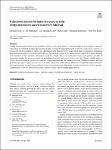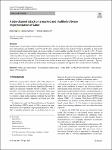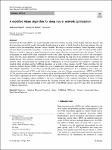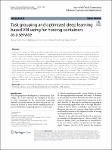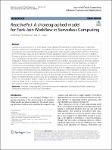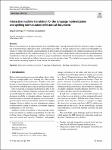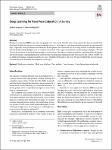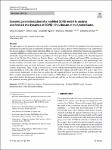Search
Author
- Osman, Ahmed I. (5)
- Daqing, Ma (3)
- Jorgensen, Ed (3)
- Li, Yan (3)
- next >
Subject
- kinh tế (26)
- Economics (12)
- programming (10)
- XRD (10)
- next >
Date issued
- 2020 - 2025 (2128)
- 2010 - 2019 (129)
- 2000 - 2009 (9)
- 1999 - 1999 (1)
Has File(s)
Search Results
Finding relevant publications in the scientific domain can be quite tedious: Accessing large-scale document collections often means to formulate an initial keyword-based query followed by many refinements to retrieve a sufficiently complete, yet manageable set of documents to satisfy one’s information need. Since keyword-based search limits researchers to formulating their information needs as a set of unconnected keywords, retrieval systems try to guess each user’s intent. In contrast, distilling short narratives of the searchers’ information needs into simple, yet precise entity-interaction graph patterns provides all information needed for a precise search. |
In this paper, we show that a software implementation of IND-CCA-secure Saber key encapsulation mechanism protected by first-order masking and shuffling can be broken by deep learning-based power analysis. Using an ensemble of deep neural networks trained at the profiling stage, we can recover the session key and the secret key from 257×N and 24×257×N traces, respectively, where N is the number of repetitions of the same easurement. The value of N depends on the implementation of the algorithm, the type of device under attack, environmental factors, acquisition noise, etc.; in our experiments N=10 is sufficient for a successful attack. The neural networks are trained on a combination of 80% of traces from the profiling device with a known shuffling order and 20% of traces from the d... |
Deep Neural Networks (DNNs) are widely regarded as the most effective learning tool for dealing with large datasets, and they have been successfully used in thousands of applications in a variety of fields. Based on these large datasets, they are trained to learn the relationships between various variables. The adaptive moment estimation (Adam) algorithm, a highly efficient adaptive optimization algorithm, is widely used as a learning algorithm in various fields for training DNN models. However, it needs to improve its generalization performance, especially when training with large-scale datasets. Therefore, in this paper, we propose HN Adam, a modified version of the Adam Algorithm, to improve its accuracy and convergence speed. The HN_Adam algorithm is modified by automatically ad... |
Containers as a service (CaaS) are a kind of services that permits the organization to handle the containers more effectively. Containers are lightweight, require less computing resources, portable, and facilitate better support for microservices. In the CaaS model, containers are deployed in virtual machines, and the virtual machine runs on the physical machine. The objective of this paper is to estimate the resource required by a VM to execute a number of containers. VM sizing is a directorial process where the system administrators have to optimize the allocated resources within the permitted virtualized space. In this work, the VM sizing is carried out using the Deep Convolutional Long Short Term Memory Network (Deep-ConvLSTM), where the weights are updated by Fractional Pelican... |
Function-as-a-Service (FaaS) is an event-based reactive programming model where functions run in ephemeral stateless containers for short duration. For building complex serverless applications, function composition is crucial to coordinate and synchronize the workflow of an application. Some serverless orchestration systems exist, but they are in their primitive state and do not provide inherent support for non-trivial workflows like, Fork-Join. To address this gap, we propose a fully serverless and scalable design model ReactiveFnJ for Fork-Join workflow. The intent of this work is to illustrate a design which is completely choreographed, reactive, asynchronous, and represents a dynamic composition model for serverless applications based on Fork-Join workflow. |
The correct and robust recognition of traffic signs is indispensable to self-driving vehicles and driver-assistant systems. In this work, we propose and evaluate two network architectures for multi-expert decision systems that we test on a challenging Traffic Sign Recognition Benchmark dataset. The decision systems implement individual experts in the form of deep convolutional neural networks (CNNs). A gating network CNN acts as final decision unit and learns which individual expert CNNs are likely to contribute to an overall meaningful classification of a traffic sign. The gating network then selects the outputs of those individual expert CNNs to be fused to form the final decision. |
Historical documents are an important part of our cultural heritage. Among other task related to their processing, it is important to modernize their language in order to make them accessible to a broader audience and to achieve an orthography consistency to reduce the linguistic variation inherent in them. Language modernization and spelling normalization have those goals in mind. However, they still have a long way to go. Thus, in order to help scholars generate error-free modernizations/normalizations when the quality is essential, we propose an interactive framework based on interactive machine translation. In this work, we deployed two different interactive protocols into these tasks. We evaluated our proposal under simulated environments, observing significant reductions of th... |
Head pose estimation (HPE) is an active and popular area of research. Over the years, many approaches have constantly been developed, leading to a progressive improvement in accuracy; nevertheless, head pose estimation remains an open research topic, especially in unconstrained environments. In this paper, we will review the increasing amount of available datasets and the modern methodologies used to estimate orientation, with a special attention to deep learning techniques. We will discuss the evolution of the field by proposing a classification of head pose estimation methods, explaining their advantages and disadvantages, and highlighting the different ways deep learning techniques have been used in the context of HPE. An in-depth performance comparison and discussion is presente... |
The rapid spread of the numerous outbreaks of the coronavirus disease 2019 (COVID-19) pandemic has fueled interest in mathematical models designed to understand and predict infectious disease spread, with the ultimate goal of contributing to the decision making of public health authorities. Here, we propose a computational pipeline that dynamically parameterizes a modified SEIRD (susceptible-exposed-infected-recovered-deceased) model using standard daily series of COVID-19 cases and deaths, along with isolated estimates of population-level seroprevalence. |
Model transformations are central to model-driven software development. Applications of model transformations include creating models, handling model co-evolution, model merging, and understanding model evolution. In the past, various (semi-)automatic approaches to derive model transformations from meta-models or from examples have been proposed. These approaches require time-consuming handcrafting or the recording of concrete examples, or they are unable to derive complex transformations. We propose a novel unsupervised approach, called OCKHAM, which is able to learn edit operations from model histories in model repositories. OCKHAM is based on the idea that meaningful domain-specific edit operations are the ones that compress the model differences. |

